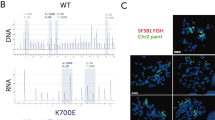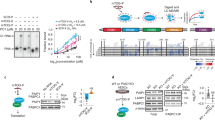Abstract
Background
Pancreatic ductal adenocarcinomas (PDACs) is a malignant disorder and is the most common pancreatic cancer type. The malignant cells depend on the uptake of asparagine (Asn) for growth. The synthesis of Asn occurs through the enzyme asparagine synthetase (ASNS). Interestingly, ASNS is known as is direct target of nonsense-mediated RNA decay (NMD). We have previously reported that NMD major factor UPF1 mutations in the pancreatic tumors. However, the relationship between NMD and the level of ASNS is unknown.
Method
We constructed point mutations by site-specific mutagenesis. To evaluate NMD magnitude, we assessed the expression ratio of an exogenously expressed wild-type and mutated β-globin mRNA with N39 allele, and five known NMD targets. Then, reverse transcription-polymerase chain reaction (RT-PCR), RT-qPCR and western bolt to determine RNA or protein levels, after knockdown of endogenous UPF1 by small RNA interference in the cells.
Results
An RNA editing event (c.3101 A > G) at UPF1 transcripts resulting in an Asparagine (p.1034) changed to a Serine is found in one primary PDAC patient. The edited UPF1 increases the ability of degrading of NMD provoking transcripts, such as β-globin mRNA with N39 allele and 5 out of 5 known endogenous NMD substrate mRNAs, including ASNS. In addition, ASNS mRNA is subjected to NMD degradation by virtue of its possessing uORFs at the 5′UTR. A reduction of endogenous ASNS RNA and the increased protein expression level is found either in the PDAC patient or in the cells with edited UPF1 at c.3101 A > G relative to the controls.
Conclusions
This edited UPF1 found in the PDAC results in hyperactivated NMD, which is tightly correlation to elevated expression level of ASNS. The targeting of knockdown of ASNS may improve the antitumor potency in PDACs.




Similar content being viewed by others
Data availability
All data generated or analyzed during this study are included in this article.
References
Chen Z, Fillmore CM, Hammerman PS, Kim CF, Wong KK (2014) Non-small-cell lung cancers: a heterogeneous set of diseases. Nat Rev Cancer 14:535–546. https://doi.org/10.1038/nrc3775
Wolpaw AJ, Dang CV (2018) Exploiting metabolic vulnerabilities of cancer with precision and accuracy. Trends Cell Biol 28:201–212. https://doi.org/10.1016/j.tcb.2017.11.006
Tsai CY, Kilberg MS, Husain SZ (2020) The role of asparagine synthetase on nutrient metabolism in pancreatic disease. Pancreatology 20:1029–1034. https://doi.org/10.1016/j.pan.2020.08.002
Herbst RS, Morgensztern D, Boshoff C (2018) The biology and management of non-small cell lung cancer. Nature 553:446–454. https://doi.org/10.1038/nature25183
Albert AE, Adua SJ, Cai WL, Arnal-Estape A, Cline GW, Liu Z, Zhao M, Cao PD, Mariappan M, Nguyen DX (2019) Adaptive protein translation by the integrated stress response maintains the proliferative and migratory capacity of lung adenocarcinoma cells. Mol Cancer Res 17:2343–2355. https://doi.org/10.1158/1541-7786.MCR-19-0245
Xiao R, Ding C, Zhu H, Liu X, Gao J, Liu Q, Lu D, Zhang N, Zhang A, Zhou H (2020) Suppression of asparagine synthetase enhances the antitumor potency of ART and artemalogue SOMCL-14-221 in non-small cell lung cancer. Cancer Lett 475:22–33. https://doi.org/10.1016/j.canlet.2020.01.035
Gommans WM, Mullen SP, Maas S (2009) RNA editing: a driving force for adaptive evolution? BioEssays 31:1137–1145. https://doi.org/10.1002/bies.200900045
Chung H, Calis JJA, Wu X, Sun T, Yu Y, Sarbanes SL, Viet Loan Dao T, Shilvock AR, Hoffmann HH, Rosenberg BR, Rice CM (2018) Human ADAR1 prevents endogenous RNA from triggering translational shutdown. Cell. https://doi.org/10.1016/j.cell.2017.12.038
Liu C, Karam R, Zhou Y, Su F, Ji Y, Li G, Xu G, Lu L, Wang C, Song M, Zhu J, Wang Y, Zhao Y, Foo WC, Zuo M, Valasek MA, Javle M, Wilkinson MF, Lu Y (2014) The UPF1 RNA surveillance gene is commonly mutated in pancreatic adenosquamous carcinoma. Nat Med 20:596–598. https://doi.org/10.1038/nm.3548
Lu J, Plank TD, Su F, Shi X, Liu C, Ji Y, Li S, Huynh A, Shi C, Zhu B, Yang G, Wu Y, Wilkinson MF, Lu Y (2016) The nonsense-mediated RNA decay pathway is disrupted in inflammatory myofibroblastic tumors. J Clin Invest 126:3058–3062. https://doi.org/10.1172/JCI86508
Mendell JT, Sharifi NA, Meyers JL, Martinez-Murillo F, Dietz HC (2004) Nonsense surveillance regulates expression of diverse classes of mammalian transcripts and mutes genomic noise. Nat Genet 36:1073–1078. https://doi.org/10.1038/ng1429
Ohnishi T, Yamashita A, Kashima I, Schell T, Anders KR, Grimson A, Hachiya T, Hentze MW, Anderson P, Ohno S (2003) Phosphorylation of hUPF1 induces formation of mRNA surveillance complexes containing hSMG-5 and hSMG-7. Mol Cell 12:1187–1200. https://doi.org/10.1016/s1097-2765(03)00443-x
Franks TM, Singh G, Lykke-Andersen J (2010) Upf1 ATPase-dependent mRNP disassembly is required for completion of nonsense- mediated mRNA decay. Cell 143:938–950. https://doi.org/10.1016/j.cell.2010.11.043
Chamieh H, Ballut L, Bonneau F, Le Hir H (2008) NMD factors UPF2 and UPF3 bridge UPF1 to the exon junction complex and stimulate its RNA helicase activity. Nat Struct Mol Biol 15:85–93. https://doi.org/10.1038/nsmb1330
Chakrabarti S, Jayachandran U, Bonneau F, Fiorini F, Basquin C, Domcke S, Le Hir H, Conti E (2011) Molecular mechanisms for the RNA-dependent ATPase activity of Upf1 and its regulation by Upf2. Mol Cell 41:693–703. https://doi.org/10.1016/j.molcel.2011.02.010
Okada-Katsuhata Y, Yamashita A, Kutsuzawa K, Izumi N, Hirahara F, Ohno S (2012) N- and C-terminal Upf1 phosphorylations create binding platforms for SMG-6 and SMG-5:SMG-7 during NMD. Nucleic Acids Res 40:1251–1266. https://doi.org/10.1093/nar/gkr791
Neu-Yilik G, Amthor B, Gehring NH, Bahri S, Paidassi H, Hentze MW, Kulozik AE (2011) Mechanism of escape from nonsense-mediated mRNA decay of human beta-globin transcripts with nonsense mutations in the first exon. RNA 17:843–854. https://doi.org/10.1261/rna.2401811
Lykke-Andersen S, Jensen TH (2015) Nonsense-mediated mRNA decay: an intricate machinery that shapes transcriptomes. Nat Rev Mol Cell Biol 16:665–677. https://doi.org/10.1038/nrm4063
Su N, Pan YX, Zhou M, Harvey RC, Hunger SP, Kilberg MS (2008) Correlation between asparaginase sensitivity and asparagine synthetase protein content, but not mRNA, in acute lymphoblastic leukemia cell lines. Pediatr Blood Cancer 50:274–279. https://doi.org/10.1002/pbc.21213
Dimitriou H, Choulaki C, Perdikogianni C, Stiakaki E, Kalmanti M (2014) Expression levels of ASNS in mesenchymal stromal cells in childhood acute lymphoblastic leukemia. Int J Hematol 99:305–310. https://doi.org/10.1007/s12185-014-1509-y
Chen L, Li Y, Lin CH, Chan TH, Chow RK, Song Y, Liu M, Yuan YF, Fu L, Kong KL, Qi L, Li Y, Zhang N, Tong AH, Kwong DL, Man K, Lo CM, Lok S, Tenen DG, Guan XY (2013) Recoding RNA editing of AZIN1 predisposes to hepatocellular carcinoma. Nat Med 19:209–216. https://doi.org/10.1038/nm.3043
Chan TH, Lin CH, Qi L, Fei J, Li Y, Yong KJ, Liu M, Song Y, Chow RK, Ng VH, Yuan YF, Tenen DG, Guan XY, Chen L (2014) A disrupted RNA editing balance mediated by ADARs (adenosine deaminases that act on RNA) in human hepatocellular carcinoma. Gut 63:832–843. https://doi.org/10.1136/gutjnl-2012-304037
Shoshan E, Mobley AK, Braeuer RR, Kamiya T, Huang L, Vasquez ME, Salameh A, Lee HJ, Kim SJ, Ivan C, Velazquez-Torres G, Nip KM, Zhu K, Brooks D, Jones SJM, Birol I, Mosqueda M, Wen Y-y, Eterovic AK, Sood AK, Hwu P, Gershenwald JE, Robertson AG, Calin GA, Markel G, Fidler IJ, Bar-Eli M (2015) Reduced adenosine-to-inosine miR-455–5p editing promotes melanoma growth and metastasis. Nat Cell Biol. https://doi.org/10.1038/ncb3110
Qin YR, Qiao JJ, Chan TH, Zhu YH, Li FF, Liu H, Fei J, Li Y, Guan XY, Chen L (2014) Adenosine-to-inosine RNA editing mediated by ADARs in esophageal squamous cell carcinoma. Cancer Res 74:840–851. https://doi.org/10.1158/0008-5472.CAN-13-2545
Anadon C, Guil S, Simo-Riudalbas L, Moutinho C, Setien F, Martinez-Cardus A, Moran S, Villanueva A, Calaf M, Vidal A, Lazo PA, Zondervan I, Savola S, Kohno T, Yokota J, Ribas de Pouplana L, Esteller M (2016) Gene amplification-associated overexpression of the RNA editing enzyme ADAR1 enhances human lung tumorigenesis. Oncogene 35:4407–4413. https://doi.org/10.1038/onc.2015.469
Jiang Q, Crews LA, Barrett CL, Chun HJ, Court AC, Isquith JM, Zipeto MA, Goff DJ, Minden M, Sadarangani A, Rusert JM, Dao KH, Morris SR, Goldstein LS, Marra MA, Frazer KA, Jamieson CH (2013) ADAR1 promotes malignant progenitor reprogramming in chronic myeloid leukemia. Proc Natl Acad Sci U S A 110:1041–1046. https://doi.org/10.1073/pnas.1213021110
Sommer B, Köhler M, Sprengel R, Seeburg PH (1991) RNA editing in brain controls a determinant of ion flow in glutamate-gated channels. Cell 67:11–19. https://doi.org/10.1016/0092-8674(91)90568-j
Graham ML (2003) Pegaspargase: a review of clinical studies. Adv Drug Deliv Rev 55:1293–1302. https://doi.org/10.1016/s0169-409x(03)00110-8
Gwinn DM, Lee AG, Briones-Martin-del-Campo M, Conn CS, Simpson DR, Scott AI, Le A, Cowan TM, Ruggero D, Sweet-Cordero EA (2018) Oncogenic KRAS regulates amino acid homeostasis and asparagine biosynthesis via ATF4 and alters sensitivity to L-asparaginase. Cancer Cell. https://doi.org/10.1016/j.ccell.2017.12.003
Pieters R, Hunger SP, Boos J, Rizzari C, Silverman L, Baruchel A, Goekbuget N, Schrappe M, Pui CH (2011) L-asparaginase treatment in acute lymphoblastic leukemia: a focus on Erwinia asparaginase. Cancer 117:238–249. https://doi.org/10.1002/cncr.25489
Knott SRV, Wagenblast E, Khan S, Kim SY, Soto M, Wagner M, Turgeon M-O, Fish L, Erard N, Gable AL, Maceli AR, Dickopf S, Papachristou EK, D’Santos CS, Carey LA, Wilkinson JE, Harrell JC, Perou CM, Goodarzi H, Poulogiannis G, Hannon GJ (2018) Asparagine bioavailability governs metastasis in a model of breast cancer. Nature. https://doi.org/10.1038/nature25465
Funding
This study was supported by the National Natural Science Foundation of China (No. 81871992).
Author information
Authors and Affiliations
Contributions
JH and ZW conception, design and analysis of data and performed the data analyses. SY contributed significantly to analysis and manuscript preparation. GL contributed to the conception of the clinic study. YL contributed to the whole study and wrote the manuscript.
Corresponding authors
Ethics declarations
Conflict of interest
The authors have no conflicts of interest to declare that are relevant to the content of this article.
Ethical approval
The study observed the ethical rules on clinical studies established by Ethics Committee of Shanghai Changhai Hospital (Shanghai, China) according to the national guidelines.
Consent to participate
All participants were provided written informed consent for the whole study.
Additional information
Publisher's Note
Springer Nature remains neutral with regard to jurisdictional claims in published maps and institutional affiliations.
Supplementary Information
Below is the link to the electronic supplementary material.
Rights and permissions
About this article
Cite this article
Hu, J., Wang, Z., Yang, S. et al. The edited UPF1 is correlated with elevated asparagine synthetase in pancreatic ductal adenocarcinomas. Mol Biol Rep 49, 3713–3720 (2022). https://doi.org/10.1007/s11033-022-07211-9
Received:
Accepted:
Published:
Issue Date:
DOI: https://doi.org/10.1007/s11033-022-07211-9




